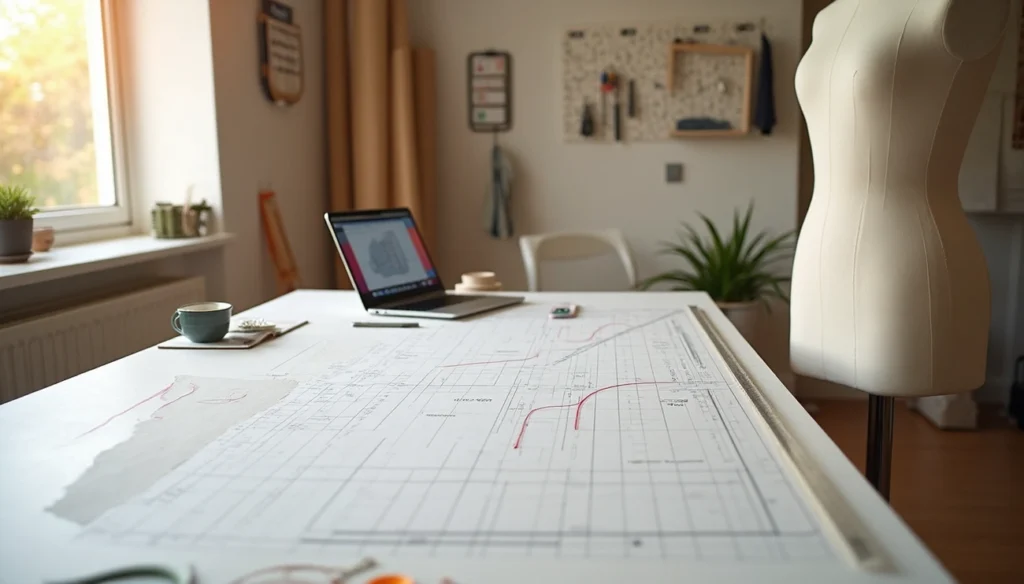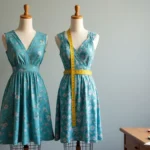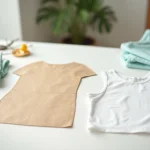Make sewing patterns using hand drafting, digital software, or online pattern generators like FreeSewing and Sewist. Platforms such as Mood Fabrics and Fair Fit Studio also offer free tools and tutorials. Beginners and professionals can design custom patterns online for dresses, skirts, tops, and more, often at no cost.
If you don’t know where to make sewing patterns, then this guide is for you. Read the rest of the article to learn how to get started and everything.
Why Make Your Own Sewing Patterns?
Have you ever felt frustrated when a store-bought pattern just doesn’t fit right? Many sewers struggle with commercial patterns that never quite match their body shape. This frustration is precisely why learning how to make your own sewing patterns has become increasingly popular among fashion enthusiasts and home sewers alike.
Limitations of store-bought patterns
Commercial patterns come with significant drawbacks that can turn your sewing project into a challenging experience. One major issue is sizing inconsistency – pattern sizing is completely different from ready-to-wear clothing. This discrepancy creates confusion and often psychological barriers for beginners.
Furthermore, many commercial pattern instructions assume a certain level of sewing knowledge. They frequently skip steps or use jargon without proper explanation. This lack of clarity can be particularly discouraging for newcomers to sewing.
The limited design options present another significant obstacle. Despite the variety available, you might still struggle to find exactly what you’re looking for in pattern books. As one experienced sewer noted, “You can still find yourself stuck looking for a particular shape and style, despite the choice”.
Benefits of custom-fit designs
Custom-fit is fundamentally about personalization. According to industry experts, standard small, medium, and large sizes only match about 15% of men, highlighting how poorly mass-produced clothing serves most body types. When you create your own patterns, you can accommodate your unique body proportions right from the start.
A properly fitted garment not only looks better but provides unparalleled comfort. Rather than constantly making repetitive adjustments to each new commercial pattern, custom patterns allow you to address your specific body measurements once and then focus on design variations.
The longevity of custom-made clothing represents another compelling benefit. Most dressmakers choose quality materials that won’t pill or look worn even after years of use. Moreover, the construction techniques employed in custom sewing create stronger seams, improving both the appearance and durability of garments.
Creative freedom and personalization
Perhaps the most exhilarating aspect of making your own patterns is the creative liberation it provides. When designers rely solely on pre-made patterns, they’re limited by what’s available or others’ vision. Pattern making empowers you to modify, combine, or create entirely new silhouettes without constraints.
In fact, creating your own patterns transforms sewing into a more thoughtful process. As one sewer described, “The slower and more considered route of making them for yourself is the perfect antidote to fast fashion”. This mindful approach fosters a deeper connection with your clothing.
The self-sufficiency aspect shouldn’t be overlooked either. There’s something remarkably satisfying about drafting a pattern when inspiration strikes rather than waiting for stores to open or online purchases to arrive. This resourcefulness allows you to bring your creative visions to life on your schedule.
Best Online Tools for Pattern Making
Technology has opened exciting doors for sewers looking to create custom-fitting patterns without mastering complex drafting techniques. Online pattern making tools offer powerful features that were once only available to professional designers. Let’s explore five outstanding options for where to make sewing patterns digitally.
Tailornova
Tailornova stands out as a patent-pending online fashion design software that helps create unlimited designs faster than traditional methods. What makes this tool particularly valuable is its ability to visualize creations in 3D and generate custom-fitted patterns in seconds. The platform allows you to:
- Customize your own true-to-life 3D FitModel™ to replicate any figure, measurements, and body shape
- Preview 3D garment samples before cutting fabric
- Access made-to-measure sewing patterns ready to download, cut, and sew
Since its launch, Tailornova has become a game-changer for many designers. As one fashion designer noted, “Without it, I would have spent countless hours on patterns, grading and fit”. The standard subscription price is $49 per month, making it a professional-grade option.
Sewist
Sewist (formerly Lekala) offers a free online pattern drafting solution with impressive capabilities. This patented 2D/3D CAD software allows you to draft sewing patterns in the cloud without spending a dime. Essentially, Sewist is recognized as the “#1 full scale parametric online pattern drafting software”.
The platform’s mix-and-match online sewing pattern designer provides flexible options for creating custom clothing patterns. Users can design and download patterns in their exact custom size, making it an accessible entry point for beginners looking to create personalized patterns.
PatternLab London
PatternLab London specializes in automatically drafting bespoke basic blocks and slopers designed to fit your exact measurements. The platform dramatically speeds up the pattern making process by creating custom basic blocks that fit you or your client perfectly.
Their approach is unique—instead of transforming or grading existing patterns, PatternLab drafts each bespoke basic block from scratch, “point-to-point and measurement by measurement, to get a unique fit each and every time”. The platform offers both PDF paper patterns and editable digital ePatterns in SVG format that can be imported into Adobe Illustrator or Inkscape.
Lekala
Lekala provides an impressive collection of made-to-measure sewing patterns that require only four measurements to create a perfect fit. The platform boasts thousands of tested styles with new patterns added weekly.
A major advantage of Lekala is its affordability—they offer competitive low prices plus numerous free patterns. Once you purchase a pattern, it’s emailed to you within minutes, ready to print on your home printer. All patterns come with sewing instructions and are royalty-free, meaning you can sew, sell, or even mass produce garments made from them.
Seamly2D
For those who prefer open-source solutions, Seamly2D offers free patternmaking software available for Windows, MacOS, and Linux. This community-supported tool emphasizes democratizing fashion through accessible technology.
What sets Seamly2D apart is its parametric approach to pattern drafting, which allows measurements to be adjusted dynamically to fit different sizes without redrawing the pattern. Each Seamly2D pattern can read multi-size measurement files for standardized sizes or individual measurement files for custom-fit.
The software works in three modes—Draft, Piece, and Layout—and includes professional features like seam allowances, notches, labels, and grainline inclusion. For those on a budget who don’t mind a learning curve, Seamly2D represents a powerful free alternative to commercial options.
How to Use a Sewing Pattern Creator
Once you’ve chosen your preferred online sewing pattern creator, the next step is learning how to effectively use it to create perfectly fitted patterns. Getting started might seem overwhelming at first, however with the right approach, you’ll soon be creating custom patterns with ease.
Step-by-step guide to using online tools
Many pattern making programs follow a similar workflow. Initially, you’ll need to create an account on your chosen platform. After logging in, you’ll typically see options to either start a new project or browse existing patterns. For beginners, starting with a basic template is often easier than creating from scratch.
Most platforms like Seamly2D offer three primary modes—Draft mode for creating the pattern, Piece mode for organizing pattern pieces, and Layout mode for arranging pieces for printing. The interface might seem complex at first glance, so take time to familiarize yourself with the toolbar and available functions.
Uploading or entering your measurements
Accurate measurements are crucial for well-fitting patterns. Many programs allow you to create individual measurement files or multi-measurement files, which is perfect for grading patterns. When entering measurements, be precise—even small inaccuracies can affect the final garment fit.
Some platforms like SeamlyMe let you link patterns to measurement files, so if your measurements change, you simply update the file, and the software automatically adjusts your patterns. This feature is especially useful for custom work or personal projects where body measurements might fluctuate over time.
Choosing garment styles and features
After setting up your measurements, it’s time to select your garment style. Most pattern creators offer ready-to-use blocks as starting points. From there, you can modify design elements like necklines, sleeves, or hemlines according to your preference.
Look beyond the sample images when choosing styles. As one expert suggests, “DO NOT LOOK AT THE PICTURE ON THE FRONT OF THE PATTERN”. Focus on the line drawings that show the actual shape and seams without being influenced by fabric choices or styling. Search online for other makers who have used the same pattern to see it in different fabrics and on various body types.
Downloading and printing your pattern
Once you’ve finalized your design, it’s time to download and print. Most platforms offer multiple file formats, including PDF for home printing or larger formats for professional printing. For home printing, ensure your printer settings are correct—select “Actual Size” or “100%” and never “Fit to Page”.
Always print a test page first and measure the test square (usually 60mm x 60mm) to verify the scale. For assembling printed patterns, cut along one long side and one short side of each sheet, then align the matching symbols (often triangles or diamonds) and secure with tape or glue. If using a print service, request printing at 100% with no scaling or tiling.
Offline Options for Pattern Making
Despite the digital revolution in pattern making, traditional offline methods remain fundamental to the craft. Many professional sewists consider these time-tested approaches essential for truly understanding garment construction.
Books like Armstrong and Aldrich
For those wondering where to make sewing patterns without digital tools, two textbooks consistently top the recommendations. “Patternmaking for Fashion Design” by Helen Joseph-Armstrong serves as the cornerstone reference in most fashion design programs. Armstrong’s comprehensive approach covers fundamentals thoroughly, making it ideal for beginners who need clear guidance.
Meanwhile, “Metric Pattern Cutting for Women’s Wear” by Winifred Aldrich offers a more concise yet powerful alternative. Many sewists find Aldrich’s book easier to follow, though it assumes some familiarity with basic concepts like slash and spread techniques. Unlike Armstrong’s approach, Aldrich requires readers to work out more details independently, making it suitable for those already comfortable with pattern fundamentals.
Drafting patterns by hand
Creating patterns manually requires specific tools: paper, pencil, eraser, straight and curved rulers, tape measure, and calculator. The process typically begins with drafting a basic block (or sloper) based on your measurements.
Remember that pattern drafting is inherently iterative. As one expert notes, “Your first block isn’t perfect and usually has to be drafted again”. Some designs may require multiple iterations, taking up to a week to achieve the desired fit. This patience ultimately yields patterns perfectly tailored to your unique proportions.
Using muslin to test and refine fit
Muslin-making forms the critical foundation of any well-fitted garment. This test garment reveals fitting issues that measurements alone cannot predict—asymmetries, curves, and unique body proportions that affect how fabric drapes.
For best results, use unbleached cotton muslin that mimics your final fabric’s weight. Mark crucial reference points such as bust, waist, and hiplines horizontally across the garment. These markings help assess whether pattern pieces are properly balanced.
After assembly, treat your muslin as a laboratory for refinement. Use pins, markers, and scissors freely, making notes directly on the fabric. Once perfected, your muslin becomes the template for your final pattern, ensuring your finished garment fits flawlessly.
Tips for Beginners in Pattern Making
Beginning your pattern making journey can feel overwhelming, but with the right approach, you can develop this valuable skill step by step. I’ve discovered that patience and practical strategies make all the difference when learning how to make your own sewing patterns.
Start with simple garments
First, focus on mastering basic shapes. Before diving into complex designs, make sure you’ve sewn a dress, shirt, pants, skirt, and jacket to understand how commercial patterns come together. These fundamental garments teach you pattern structure and assembly order. Many pattern making experts recommend starting with a skirt as it’s the easiest type of garment. Understanding skirt construction provides skills you’ll later use for jackets, coats, and dresses.
Use cheap fabric for testing
Creating test garments is absolutely essential for successful pattern making. There are generally two approaches: making a muslin or sewing a test garment. Muslin is an inexpensive, thin fabric perfect for testing, where you only need to use essential pieces to gage fit. These test pieces are typically assembled using pins or basting stitches. Alternatively, you can create a full test garment using inexpensive fabric. As one sewist noted after making a test dress: “I’m really glad I did a test run…despite measuring to see what size I should need, I actually needed to size down at least one, if not two sizes”.
Learn from mistakes and iterate
Understand that your first pattern block won’t be perfect. Most designs go through multiple iterations—sometimes three versions over a week—to achieve the desired fit. Common beginner mistakes include forgetting to repeat elements at pattern edges, creating unintentional spaces (“tram tracking”), and adding too many different elements without considering how they work together. Remember that stepping away from frustrating projects temporarily can provide fresh perspective when you return.
Join sewing communities for support
Finally, connect with fellow pattern makers. A sewing community takes your skills to the next level by providing support, advice, and friendship. Consider taking classes at local fabric stores, joining weekly sewing groups, or participating in online communities. Instagram’s sewing community is particularly welcoming—use relevant hashtags to find like-minded creators. Facebook groups organized around specific interests like “pattern-making” or location-based sewing circles offer valuable connections.
Conclusion
Pattern making offers a transformative journey for sewers seeking perfect fit and creative expression. Throughout this guide, we’ve explored numerous paths to creating your own sewing patterns – each with distinct advantages depending on your skill level and preferences.
Digital solutions like Tailornova and Sewist provide powerful tools that significantly reduce the learning curve, while traditional methods using resources from Armstrong and Aldrich build foundational knowledge many professionals still consider essential. Both approaches ultimately lead to the same destination: garments tailored specifically to your unique body and style preferences.
Remember that learning to create patterns represents a gradual process rather than an overnight achievement. Start with basic garments, test extensively with inexpensive fabrics, and allow yourself room to make mistakes. Additionally, consider joining sewing communities where fellow enthusiasts can offer guidance through challenging projects.


